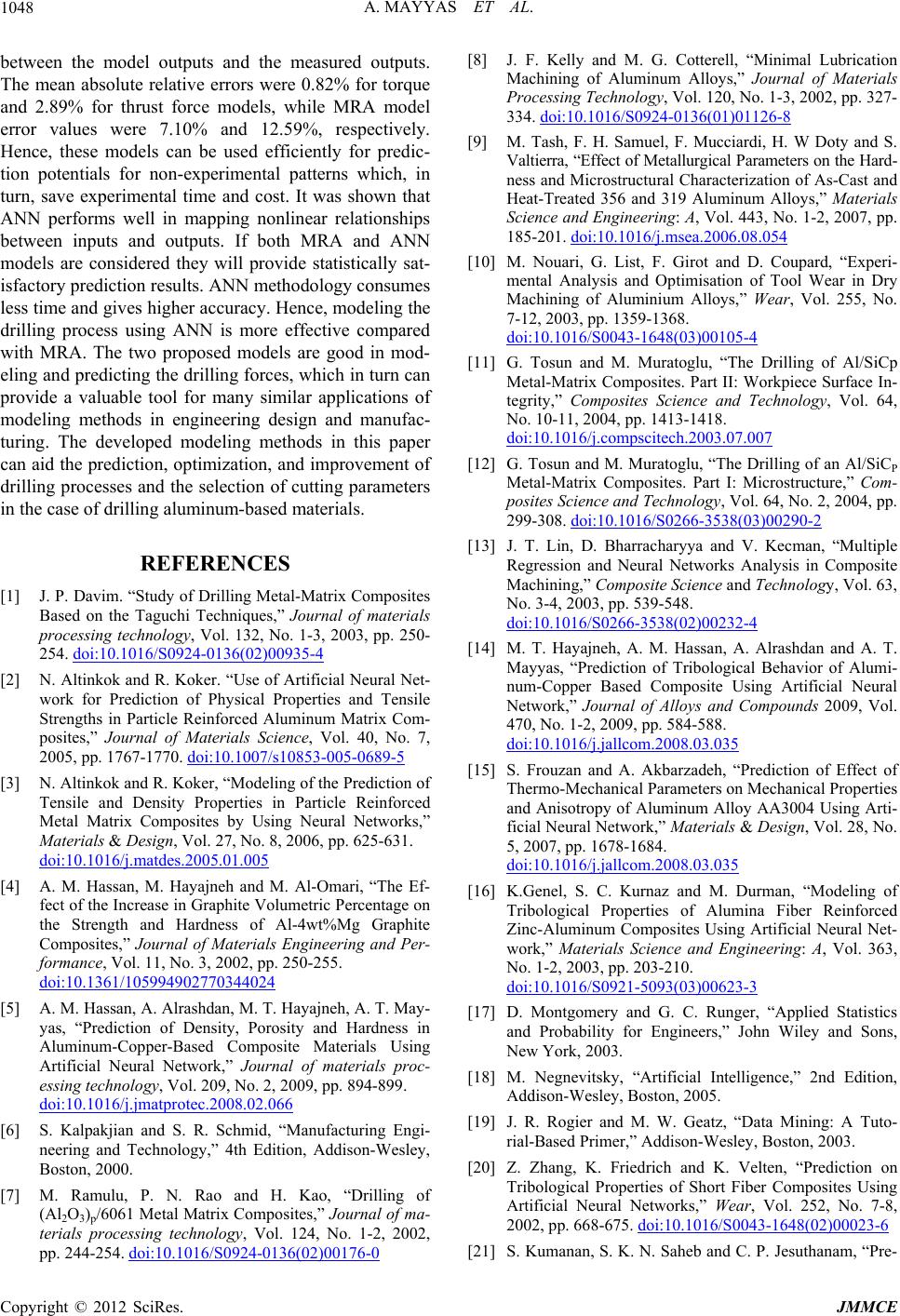
A. MAYYAS ET AL.
1048
between the model outputs and the measured outputs.
The mean absolute relative errors were 0.82% for torque
and 2.89% for thrust force models, while MRA model
error values were 7.10% and 12.59%, respectively.
Hence, these models can be used efficiently for predic-
tion potentials for non-experimental patterns which, in
turn, save experimental time and cost. It was shown that
ANN performs well in mapping nonlinear relationships
between inputs and outputs. If both MRA and ANN
models are considered they will provide statistically sat-
isfactory prediction results. ANN methodology consumes
less time and gives higher accuracy. Hence, modeling the
drilling process using ANN is more effective compared
with MRA. The two proposed models are good in mod-
eling and predicting the drilling forces, which in turn can
provide a valuable tool for many similar applications of
modeling methods in engineering design and manufac-
turing. The developed modeling methods in this paper
can aid the prediction, optimization, and improvement of
drilling processes and the selection of cutting parameters
in the case of drilling aluminum-based materials.
REFERENCES
[1] J. P. Davim. “Study of Drilling Metal-Matrix Composites
Based on the Taguchi Techniques,” Journal of materials
processing technology, Vol. 132, No. 1-3, 2003, pp. 250-
254. doi:10.1016/S0924-0136(02)00935-4
[2] N. Altinkok and R. Koker. “Use of Artificial Neural Net-
work for Prediction of Physical Properties and Tensile
Strengths in Particle Reinforced Aluminum Matrix Com-
posites,” Journal of Materials Science, Vol. 40, No. 7,
2005, pp. 1767-1770. doi:10.1007/s10853-005-0689-5
[3] N. Altinkok and R. Koker, “Modeling of the Prediction of
Tensile and Density Properties in Particle Reinforced
Metal Matrix Composites by Using Neural Networks,”
Materials & Design, Vol. 27, No. 8, 2006, pp. 625-631.
doi:10.1016/j.matdes.2005.01.005
[4] A. M. Hassan, M. Hayajneh and M. Al-Omari, “The Ef-
fect of the Increase in Graphite Volumetric Percentage on
the Strength and Hardness of Al-4wt%Mg Graphite
Composites,” Journal of Materials Engineering and Per-
formance, Vol. 11, No. 3, 2002, pp. 250-255.
doi:10.1361/105994902770344024
[5] A. M. Hassan, A. Alrashdan, M. T. Hayajneh, A. T. May-
yas, “Prediction of Density, Porosity and Hardness in
Aluminum-Copper-Based Composite Materials Using
Artificial Neural Network,” Journal of materials proc-
essing technology, Vol. 209, No. 2, 2009, pp. 894-899.
doi:10.1016/j.jmatprotec.2008.02.066
[6] S. Kalpakjian and S. R. Schmid, “Manufacturing Engi-
neering and Technology,” 4th Edition, Addison-Wesley,
Boston, 2000.
[7] M. Ramulu, P. N. Rao and H. Kao, “Drilling of
(Al2O3)p/6061 Metal Matrix Composites,” Journal of ma-
terials processing technology, Vol. 124, No. 1-2, 2002,
pp. 244-254. doi:10.1016/S0924-0136(02)00176-0
[8] J. F. Kelly and M. G. Cotterell, “Minimal Lubrication
Machining of Aluminum Alloys,” Journal of Materials
Processing Technology, Vol. 120, No. 1-3, 2002, pp. 327-
334. doi:10.1016/S0924-0136(01)01126-8
[9] M. Tash, F. H. Samuel, F. Mucciardi, H. W Doty and S.
Valtierra, “Effect of Metallurgical Parameters on the Hard-
ness and Microstructural Characterization of As-Cast and
Heat-Treated 356 and 319 Aluminum Alloys,” Materials
Science and Engineering: A, Vol. 443, No. 1-2, 2007, pp.
185-201. doi:10.1016/j.msea.2006.08.054
[10] M. Nouari, G. List, F. Girot and D. Coupard, “Experi-
mental Analysis and Optimisation of Tool Wear in Dry
Machining of Aluminium Alloys,” Wear, Vol. 255, No.
7-12, 2003, pp. 1359-1368.
doi:10.1016/S0043-1648(03)00105-4
[11] G. Tosun and M. Muratoglu, “The Drilling of Al/SiCp
Metal-Matrix Composites. Part II: Workpiece Surface In-
tegrity,” Composites Science and Technology, Vol. 64,
No. 10-11, 2004, pp. 1413-1418.
doi:10.1016/j.compscitech.2003.07.007
[12] G. Tosun and M. Muratoglu, “The Drilling of an Al/SiCP
Metal-Matrix Composites. Part I: Microstructure,” Com-
posites Science and Technology, Vol. 64, No. 2, 2004, pp.
299-308. doi:10.1016/S0266-3538(03)00290-2
[13] J. T. Lin, D. Bharracharyya and V. Kecman, “Multiple
Regression and Neural Networks Analysis in Composite
Machining,” Composite Science and Technology, Vol. 63,
No. 3-4, 2003, pp. 539-548.
doi:10.1016/S0266-3538(02)00232-4
[14] M. T. Hayajneh, A. M. Hassan, A. Alrashdan and A. T.
Mayyas, “Prediction of Tribological Behavior of Alumi-
num-Copper Based Composite Using Artificial Neural
Network,” Journal of Alloys and Compounds 2009, Vol.
470, No. 1-2, 2009, pp. 584-588.
doi:10.1016/j.jallcom.2008.03.035
[15] S. Frouzan and A. Akbarzadeh, “Prediction of Effect of
Thermo-Mechanical Parameters on Mechanical Properties
and Anisotropy of Aluminum Alloy AA3004 Using Arti-
ficial Neural Network,” Materials & Design, Vol. 28, No.
5, 2007, pp. 1678-1684.
doi:10.1016/j.jallcom.2008.03.035
[16] K.Genel, S. C. Kurnaz and M. Durman, “Modeling of
Tribological Properties of Alumina Fiber Reinforced
Zinc-Aluminum Composites Using Artificial Neural Net-
work,” Materials Science and Engineering: A, Vol. 363,
No. 1-2, 2003, pp. 203-210.
doi:10.1016/S0921-5093(03)00623-3
[17] D. Montgomery and G. C. Runger, “Applied Statistics
and Probability for Engineers,” John Wiley and Sons,
New York, 2003.
[18] M. Negnevitsky, “Artificial Intelligence,” 2nd Edition,
Addison-Wesley, Boston, 2005.
[19] J. R. Rogier and M. W. Geatz, “Data Mining: A Tuto-
rial-Based Primer,” Addison-Wesley, Boston, 2003.
[20] Z. Zhang, K. Friedrich and K. Velten, “Prediction on
Tribological Properties of Short Fiber Composites Using
Artificial Neural Networks,” Wear, Vol. 252, No. 7-8,
2002, pp. 668-675. doi:10.1016/S0043-1648(02)00023-6
[21] S. Kumanan, S. K. N. Saheb and C. P. Jesuthanam, “Pre-
Copyright © 2012 SciRes. JMMCE